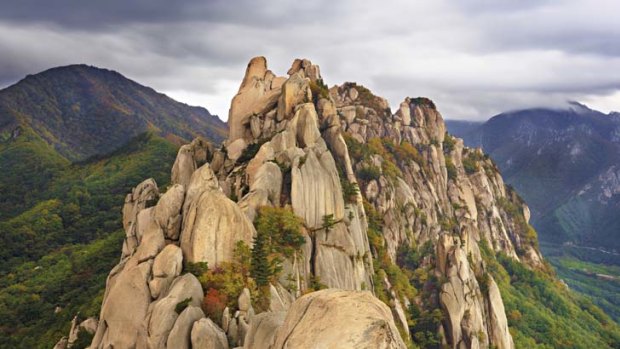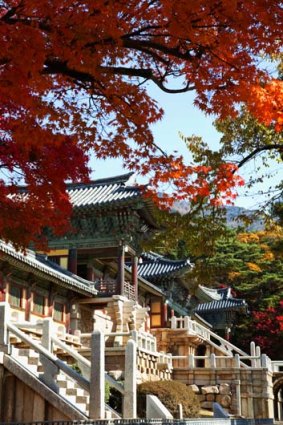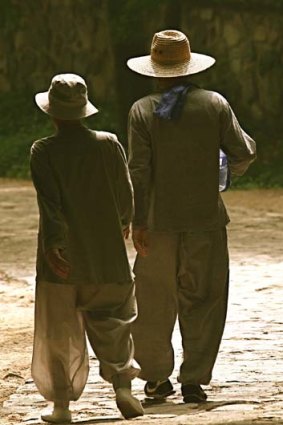
SeorakSan National Park near Sokcho.Credit: Getty Images
From temple stays to royal sites, national parks to the national dish, South Korea is a treasure trove, writes Steve McKenna.
SEOUL is more fun than the critics, bowled over by its east Asian neighbours Beijing and Tokyo, would have you believe.
On my first day in the under-hyped South Korean capital, I watched the vibrant changing-of-the-guards ceremony at the Gyeongbok royal palace, I shopped in the fashion boutiques of the funky Apgujeong district, I scoffed live baby octopus in the atmospheric Noryangjin fish market then drank soju (distilled Korean rice liquor) in a pub mocked up like Prague Castle.

Bulguksa Temple.Credit: Getty Images
I was keen, however, to go beyond this bustling, traffic-clogged city of 10 million people.
The cheerful Koreans I spoke to on the city's metro (and in the pub) agreed, claiming that to see - and feel - the real soul of their country, I needed to get well out of Seoul. They suggested a list of places to visit. Ticking them off was a treat.
Sokcho
A three-hour coach ride across the peninsula, Sokcho is a sleepy coastal city edging the Sea of Japan (East Sea). It has half-decent beaches, scenic lagoons (ideal for walking or cycling round) and a feast of seafood stalls and markets (delicious sushi and deep-fried shrimp are local favourites).

Gyeongju is home to royal tombs.Credit: Getty Images
Sokcho is known mainly as the gateway to Seoraksan National Park. This beautiful, mountainous expanse a short bus ride from town backs on to the North Korean border and offers several days' worth of hiking. Rising early one bright spring day, I tackle the winding, ascending trail to Ulsanbawi Rock, a spectacular craggy peak.
After two hours trundling through woodland, skirting rivers, passing Buddhist temples and enduring thigh-straining climbs up stone steps and metal ladders, my prize is super-fresh air and splendid views of Ulsanbawi, the coast and the park's green, unspoiled interior.
Sitting on a boulder, getting my breath back, I'm also the recipient of Korean generosity. A young family who speak no English approach, offering some of their picnic. Thanking them, I recall a passage from the book I'm reading, Simon Winchester's Korea: A Walk through the Land of Miracles, in which the English author traversed the country on foot in the late 1980s. He wrote: "Quite a few cars going the same way stopped and offered me a lift. And they would whistle with amazement and offer sweets and chocolate, anything they had, to help me on my way. That day, in the sunshine, it seemed that there were no more hospitable people on earth."
On my way back down, I pass middle-age and elderly ladies, all wearing baseball caps with ludicrously elongated sun visors. They smile, say "Ahn-nyeong" - hello - and offer me mints. Then a gang of teenage schoolgirls rush past, waving and squealing "Handsome man! Handsome man!" Sensing my embarrassment, their teacher stops and explains that it's OK - they say that to all the young foreign men.
Andong
The story goes that when the Queen visited South Korea in 1999, she asked to be taken to the "most Korean place in Korea". She was brought to Andong, the self-proclaimed capital of "Korean Spiritual Culture".
Embedded in a lush region of lakes and mountains, Andong blossomed under both the Goryeo (918-1392) and Joseon (1392-1910) dynasties. Its city centre isn't particularly picturesque (it was heavily damaged then rebuilt because of the 1950s Korean War). But treasures abound on the verdant outskirts. Tourists can peruse the homes of ancient nobility and the academies that once drew the country's leading Confucian scholars, while the Andong Folk Museum delves into traditions and folklore.
Andong's most intriguing spot and one of the places blessed with the Queen's presence is Hahoe Folk Village. Nudging a horseshoe bend of the Nakdong River, this UNESCO World Heritage-listed site has been home to the same clan since the 16th century and is sprinkled with Joseon-style architecture (aristocratic tile-roof houses and thatched servants' homes with chimneys).
Although Hahoe has moved with the times - I see Daewoos, satellite dishes and vending machines as I walk the village's narrow lanes - it remains a world away from Seoul and its semi-bygone vibe is enhanced by the centuries-old customs that have survived the generations.
They make their own soju here - Andong-style, at 45 per cent proof, twice as strong as regular soju - and are experts at crafting wooden totem poles and masks with vivid, flamboyant facial expressions.
Several times a week, villagers don these masks and perform vibrant, shamanistic folk dances, casting a satirical light on the age-old conflicts between the village's upper and lower classes. Hahoe is one of the venues of Andong's annual Maskdance Festival, which lures mask dancers and entertainers from across the country and the world. This year it's on from September 30 to October 10. maskdance.com/english/main.asp.
Gyeongju
Between the 1st century BC and the 10th century AD, much of the Korean Peninsula was ruled by the Silla dynasty and Gyeongju was their capital.
Though not quite in the same league as the European cities of Rome or Athens, Gyeongju feels, in part, like an open-air museum. Indeed, some call it Korea's Kyoto.
Clusters of eye-catching grassy mounds holding the tombs of Silla royalty and court officials are scattered across the downtown area, notably in the gorgeously landscaped, flower-packed Daereungwon Park, which is also home to the Cheomseongdae Observatory. Built in 634 during the reign of Queen Seonduk, it's thought to be the oldest observatory in the Far East and, translated into English, means star-gazing tower.
Like Andong - a two-hour train ride south - Gyeongju is hedged by historic jewels. Nearby Mount Namsan is dotted with shrines and temples and draws hikers and spiritualists, while the stunning Bulguksa Temple is the region's finest testament to Buddhism - which became the official faith of the Silla kingdom in 527, almost two centuries after it had drifted over from China.
I admire the temple's magnificent architecture and its colourful paper lanterns, then join families, schoolchildren, cap-clad elderly women and young couples holding hands and wearing matching T-shirts, on a shaded trail leading to the Seokguram Grotto.
This granite sanctuary is carved into a mountainside and contains a huge statue of a seated Buddha wearing a serene expression of meditation at the moment of enlightenment. Like Bulguksa, it's a UNESCO World Heritage site and part of the Silla dynasty's revered cultural legacy.
Later that evening, I do as the Koreans (often) do and have a barbecue - in a restaurant, DIY-style, cooking myself strips of pork, beef, chicken and fish on a grill dug into my table. I have various side dishes, including kimchi (fermented cabbage, eaten with almost everything in Korea), and have way too much soju. As I tap thimble-size glasses with the Koreans eating next to me, I reflect on another passage in Winchester's travelogue. "Koreans," he wrote, "often drink with the specific objective of becoming drunk and what might pass for extreme courtesy at table is simply an elegant way of ensuring that this happens."
Hwagyesa
Head slightly sore, my carnivorous impulses sated, I'm after a relaxing detox spot. Where better, I think, than to hole up in a templeSouth Korea's Buddhist temple-stay scheme is available across the country; my temporary home is the Hwagyesa Temple, founded in 1522 and nestled on the outskirts of Seoul in the shadow of the hilly, forested Bukhansan National Park.
I arrive on the Buddha's birthday and the lantern-strewn temple grounds are crammed with celebrating monks, happy families and folk dancers.
The next day everything quietens down and I spend 24 hours living - or at least trying to live - like one of the resident monks. I sleep on cushioned mats on the floor of a box-like room, wake at 3am, meditate, bow and chant to Buddha statues and mull over Hwadus (paradoxical Buddhist anecdotes, which are verbally jostled between master and student, as well as in your own mind).
I'm not a big fan of the temple's routines. Yet again I find myself concurring with Winchester: "I would like to say that the morning prayer was an exercise in serenity and beauty. But my nerves and my strained muscles made it descend into something perilously close to farce."
Temple food - rice, radish, seaweed and kimchi - isn't exactly a gastronomic delight but my stay is memorable for other reasons. I love sipping jasmine tea and having philosophical debates with my fellow temple-stayers, finding peaceful solitary spots in Hwagyesa's gardens and scaling Bukhansan park to a deathly silent vantage point that overlooks Seoul's concrete jungle.
I don't achieve enlightenment in the purest sense but by this time, I've learnt one thing. I don't know about the north but South Korea is an amazing place to visit.
The writer was a guest of the South Korean Tourist Board.
With the kids
ITS First World infrastructure, low crime rate and strong family culture make South Korea an ideal place to bring children. There's plenty to keep them occupied, too.
1 The National Museum of Korea in Seoul has its own in-house children's museum, where kids can see, touch and feel the country's heritage through hands-on programs and games. The exhibition area is divided into four themes: housing, farming, music and war. museum.go.kr.
2 Surrounded by beautiful natural scenery, Seoul Land is Korea's first amusement park; it opened just before the 1988 Olympic Games on the southern outskirts of the city (and can be reached on Subway Line 4). Spread across five themed time zones — ranging from ancient to futuristic — there are rides for all the family, including 40 roller-coasters of varying speeds. eng.seoulland.co.kr.
3 Through a mix of dramatic performances, puppet theatres and craft making, Silla Millennium Park in Gyeongju gives an educational and entertaining insight into the history and culture of Korea's revered Silla (also known as Shilla) period. smpark.co.kr/eng.
Trip notes
Getting there
Korean Air has a return fare from Sydney to Seoul for $1481. koreanair.com.
Getting around
Korea's smart, efficient and relatively inexpensive rail service links most of the big cities — some on high-speed lines (called KTX). Station ticket machines and signs are in both Korean and English, making it a cinch to travel. Tickets can also be bought online and picked up at stations. info.korail.com.
Areas not covered by the rail network can easily be reached by bus. There are several buses a day, for example, between Seoul and Sokcho. For route maps and timetables, see kobus.co.kr.
Staying there
Accommodation choices in South Korea are wide and varied, stretching from hostels, where you can bag a bed for $12 a night, to five-star multinational chains and some engaging boutique offerings in between. Seetripadvisor.com.
Two-day, one-night temple stays cost about 50,000 South Korean won ($43) a person. For details and participating spots in the temple-stay scheme, see eng.templestay.com.
More information
Sign up for the Traveller Deals newsletter
Get exclusive travel deals delivered straight to your inbox. Sign up now.